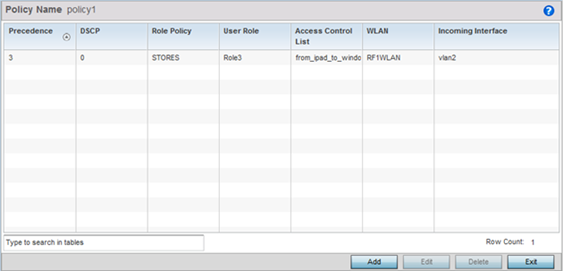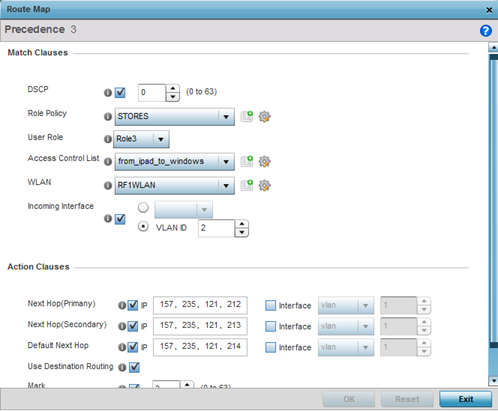Policy Based Routing (PBR)
About this task
- A means to use source address, protocol, application and traffic class as traffic routing criteria
- The ability to load balance multiple WAN uplinks
- A means to selectively mark traffic for QoS optimization
Route-maps contain a set of filters which select traffic (match clauses) and associated actions (set clauses) for routing. A routemap consists of multiple entries, each carrying a precedence value. An incoming packet is matched against the route-map with the highest precedence (lowest numerical value). If it matches, the routing decision is based on this route-map. If the packet does not match the route-map, the route-map entry with next highest precedence is matched. If the incoming packet does not match any of the route-map entries, it‘s subjected to typical destination based routing. Each route-map entry can optionally enable/disable logging.
- IP Access List - A typical IP ACL can be used for traffic permissions. The mark and log actions in ACL rules however are neglected. Route-map entries have separate logging. Only one ACL can be configured per route map entry.
- IP DSCP - Packet filtering can be performed by traffic class, as determined from the IP DSCP field. One DSCP value is configurable per route map entry. If IP ACLs on a WLAN, ports or SVI mark the packet, the new/ marked DSCP value is used for matching.
- Incoming WLAN - Packets can be filtered by the incoming WLAN. There are two
ways to match the WLAN:
- If the device doing policy based routing has an onboard radio and a packet is received on a local WLAN, then this WLAN is used for selection.
- If the device doing policy based routing does not have an onboard radio and a packet is received from an extended VLAN, then the device which received the packet passes the WLAN information in the MINT packet for the PBR router to use as match criteria.
- Client role - The client role can be used as match criteria, similar to a WLAN. Each device has to agree on a unique identifier for role definition and pass the same MINT tunneled packets.
- Incoming SVI - A source IP address qualifier in an ACL typically satisfies filter requirements. But if the host originating the packet is multiple hops away, the incoming SVI can be used as match criteria. In this context the SVI refers to the device interface performing policy based routing, and not the originating connected device.
Each route map entry has a set of match and set (action) clauses. ACL rules configured under route map entries merge to create a single ACL. Route map precedence values determine the prioritization of the rules in this merged ACL. An IP DSCP value is also added to the ACL rules.
- Next hop - The IP address of the next hop or the outgoing interface through which the packet should be routed. Up to two next hops can be specified. The outgoing interface should be a PPP, a tunnel interface or a SVI which has DHCP client configured. The first reachable hop should be used, but if all the next hops aren‘t reachable, typical destination based route lookup is performed.
- Default next hop - If a packet subjected to PBR does not have an explicit
route to the destination, the configured default next hop is used. This can
be either the IP address of the next hop or the outgoing interface. Only one
default next hop can be defined. The difference between the next hop and the
default next-hop is in case of former, PBR occurs first, then destination
based routing. In case of the latter, the order is reversed. With both
cases:
- If a defined next hop is reachable, it‘s used. If fallback is configured refer to (b).
- Do normal destination based route lookup. If a next hop is found its used, if not refer to (c).
- If default next hop is configured and reachable, it‘s used. If not, drop the packet.
- Fallback - Fallback to destination based routing if none of the configured next hops are reachable (or not configured). This is enabled by default.
- Mark IP DSCP - Set IP DSCP bits for QoS using an ACL. The mark action of the route maps takes precedence over the mark action of an ACL.

Note
A packet should optimally satisfy all the match criteria, if no match clause is defined in a route-map, it would match everything. Packets not conforming to any of the match clauses are subjected to normal destination based routing.To define a PBR configuration:




